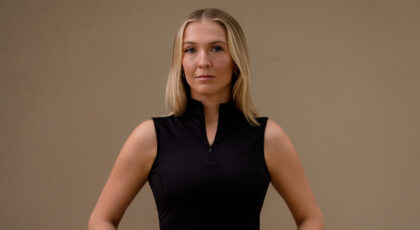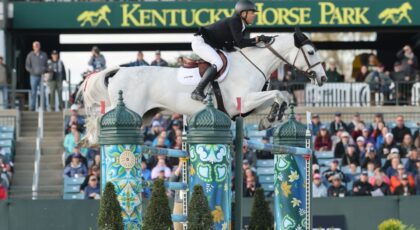“Why aren’t there more boys who ride horses?” my classmate asked.
I was in a creative writing class, and it was my turn to be “workshopped.” Basically, everyone had read my piece, and then I sat quietly while they offered feedback.
This was before I started writing for Horse Network, but it was one of those early pieces of writing where I was trying to figure out how to get the wonder of my favorite animal to translate into words. The question, however, annoyed me.
The suggestion was one of those on the list of tired asks equestrians get when they talk to people who know nothing about horses. (The questions usually have something to do with money, sex, or Secretariat.)
A decade later, I have more grace for that other student. She had very seldom seen the outside of major cities, and didn’t have much context for my experiences. She had probably scrambled to read the piece just before class started, and was trying to find something to say. I probably read her writing the exact same way; time and attention were not a thing either of us had.
Now, though, her question about boys is a crucial one.
Today, studies indicate that more than 90% of horse owners in the United States are women. They dominate other parts of the industry and make up a majority of veterinarians as well. Go to a tack shop, BreyerFest, or a Facebook group, and it’s mostly women.
While my overarching answer is yes, there should be more men and boys involved in the horse world, it is important to note that there is quite a bit of nuance here.
First, the female majority in equestrian sports isn’t universal; it is instead mostly a Western thing. (Not ‘Western’ as in cowboy, ‘western’ as in North America, Europe, and a few other places). In many other parts of the world, equestrianism is still mostly male.
Implicit bias is still a major factor as well. Men are often overrepresented in positions of power, and at the top levels of the sport, they often receive more sponsorship and media coverage. Despite the gains we have made toward equality for women, being safe and being taken as seriously are still out of reach.
I am not proud of my gut reaction when I think about this question, either. My experience with men in the horse world hasn’t always been positive, and the thought of a shift in barn dynamics makes me leery. I have dealt with too many Travis Wheatly-wannabes whose currency is cruelty.
However, I have met many wonderful men in the industry, too. The farriers who have valued my horsemanship. The older gentleman at the boarding barn who is always a pleasure to share the arena with. The cowboys who came to help me after I fell off, when the rest of the group trail ride left without me.
So why are there so few men in our horse barns?
The first reason, in my view, is gender norms. We are now a culture that associates horses with women, and this impacts marketing and infrastructure. Open a tack or supply catalog, and it’s mostly women. Instagram ad for a trekking trip? Also women. Boys often don’t see themselves represented in these spaces, and therefore, they don’t join them.
Once, I gave an impromptu lesson to a neighbor boy at a farm where I worked. All I had at the time was a lead rope and a halter, and I threw the kid on my favorite horse’s back and let him walk around. Ten minutes in, and the 9-year-old had figured out how to sit properly, turn, and even use his seat. I have never seen anyone figure something out that fast.
The owners of the farm and I tried to convince his parents that he should be allowed to come over and ride free of charge. His folks came up with some excuse, and we never saw him again. I often wonder if this would have been different if he were a girl.
The other hard truth, in my experience, is that boys face a lot more violence and ostracization from their peers than girls do for being “different”. I have had several men confide in me that they avoid horses because they “thought it made them seem like a girl.” In other words, made them weak, strange, and easy targets for beating up.
But trends suggest that men are struggling in many ways far beyond the equestrian realm.
In the United States, men have two to three times higher rates of overdose, suicide, and alcohol-related illness compared to women. They are struggling academically, dropping out at higher rates, and enrolling in higher education less.
A majority of men are earning less than they once did; that’s especially true, now, among those without college degrees. There is a massive uptick in loneliness across all people, but especially among men. In fact, roughly a quarter of men under 30 reported they having no close friends.
This affects women, too. On the extreme side, some think that the way to fix the problem is by taking away the social and economic gains women have had over the last 50 years. On the practical side, though, the challenges men are facing are making it harder to find a partner, and their lack of circles make men more dependent on one or two women for support.
I don’t think that encouraging men to ride or spend time with horses will fix every ill. Nevertheless, it will provide some with something that’s desperately needed: Another set of tools to improve their lives, and a different set of measures with which to find meaning.

Horses, as we know, are helpful at addressing loneliness. Horse people, as I have often written, have a built-in community, even if it’s just an occasional vet visit and a friendly chat with the cashier at the feed store.
Horses, themselves, provide low-stakes companionship; you don’t have to bear your darkest secrets to a horse in order to have a deep connection. Often, a groom session and some cookies will suffice.
As a teacher, myself, I have found that many of my students, especially boys, find it challenging to manage their emotions. They shut down and give up at the first sign of frustration or run screaming at the thought that they might look vulnerable in front of other people.
I, too, struggled to navigate frustration and fear, and it was horses and their trainers that taught me how to both cope with and regulate my feelings. Horses are great at providing feedback on how our emotions impact other living things; they can’t placate or sugarcoat. After a while, this clarity and information becomes less of a threat to our egos and, instead, gives us useful ways to improve our coping skills and our relationships.
The fact that women dominate the horse industry, in my view, also benefits men and boys, as it helps us to see the value in one other.
A boy’s first riding instructor is likely to be a woman. And, in many horse spaces, the thing that gains the most respect is knowledge. Mutual acceptance—and even appreciation—happen across all kinds of boundaries when one horse person wants to learn something from someone else.
This sense of equality in equestrian is a good anecdote to the rage and blind hatred many men find on the internet or at other sporting events. In addition, horses provide a different narrative for men than many of those currently available.
Unlike other sports, equestrianism, at its best, is about collaboration more than domination or aggression. Even so, it still provides plenty of adrenaline and excitement. Horses teach us that caretaking isn’t always about how much we can spend, but on how well we can anticipate the needs of the thing we love.
As for me, my horses make me feel competent, valued, and loved—something I wish more people, especially men, experienced. So, if your son, nephew, brother, friend, or even husband shows an interest, please take him to the barn and sign up for that first lesson. We would be lucky to have him.


 March 18, 2025
March 18, 2025 


























